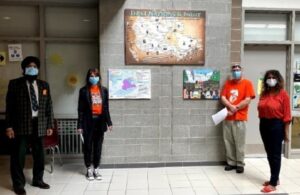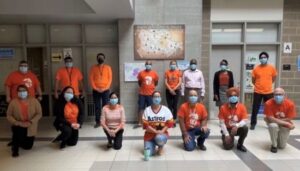Visual Land Acknowledgement ceremony held at Brampton Secondary School

By Monika Sharma
Grade 11 student, Sandalwood Heights Secondary School
BRAMPTON— Students and staff at Sandalwood Heights Secondary School in Brampton, Ont., participated in a Visual Land Acknowledgement ceremony on Sept. 30.
Speeches were presented from staff to inform the school community about the significance of a new Visual Land Acknowledgement located in a prominent position in the school’s atrium. The date was chosen because it coincided with the annual commemoration of Orange Shirt Day. Students and staff in attendance wore orange coloured shirts in participation with, and recognition of, survivors of the residential school system.
Acknowledging the traditional territories of Indigenous Peoples is one of the first steps towards following the 94 calls to action recommended by the Truth and Reconciliation Commission.
Selena Mills, an Indigenous writer, shares a perspective on the ways of reconciliation. As referenced in the speech given by Ms. Sa’d, Mills writes, “Land acknowledgments help Canadians recognize and respect Indigenous peoples’ inherent kinship beliefs when it comes to the land, especially since those beliefs were restricted for so long.” The purpose of a visual land acknowledgment, then, is to present historically accurate information so that present-day society can respect the history and culture of the Peoples of the land, and recognize that the land that we live and learn on is stolen from Indigenous peoples. Even in today’s society, Indigenous people suffer from discrimination, inequality, and injustices perpetrated by settler governments, individuals, and institutions.
Sandalwood has honoured Indigenous resistance against these forms of oppression by unveiling three works of art, each created by Indigenous people. The first piece, a map entitled “First Nation and Inuit: Traditional Names and Locations” created by Aaron R. Carapella, shows the traditional territories of the Indigenous Peoples of Turtle Island. A large part of Carapella’s research was dedicated to finding the names of the groups, in their own language, instead of the derogatory terms that were given by early European colonizers. The second piece is the “Mississaugas of the Credit First Nation Land Cessions”, showing that the land on which Sandalwood was built was recognized by the king of England as Mississauga territory. The third and final piece displayed in the building is the cover of the book We Are All Treaty People written by Maurice Switzer and illustrated by Charlie Hebert. This book consists of the retelling of Anishinabek history in chronological order and includes information about Treaties, the Indian Act, The White Paper, Residential Schools and many other crucial events that have led to the need for reconciliation.

Not only did the ceremony highlight this visual representation of Indigenous histories, but students and staff wore orange coloured shirts to show support for the annually celebrated Orange Shirt Day. This day refers to the time when Phyllis Webstad wore her new orange shirt that her grandmother gifted her for her first day of school at St. Joseph’s Residential Mission School. When she arrived, her shirt was taken away by the nuns of the school, never to be returned. Phyllis only attended the school for a year but the traumas she experienced would never be forgotten – just like the 150,000 other Indigenous children that were forced to attend residential schools over the course of Canada’s history. The government’s blatant attempt to assimilate Indigenous children and to “kill the Indian in the child” worked by opening schools away from reserves, so that the children were away from the influence of their families. This system deprived these children of their ancestral languages, and subjected them to terrible physical, mental, and sexual abuse.
The Visual Land Acknowledgment ceremony informed and educated Sandalwood students and staff about the accurate histories of Indigenous resistance, and taught them why recognizing the traditional territories of Indigenous peoples is an essential step towards reconciliation. Students who attended the event were able to further understand these histories through the speech given by Mr. Hill on the background of the Indigenous artists affiliated with the pieces. Some students commented, “It was nice to see that the school was doing something to officially recognize [Indigenous histories] and that we have signage to remind us [that we are on the traditional territories of the Indigenous peoples of Turtle Island).”

